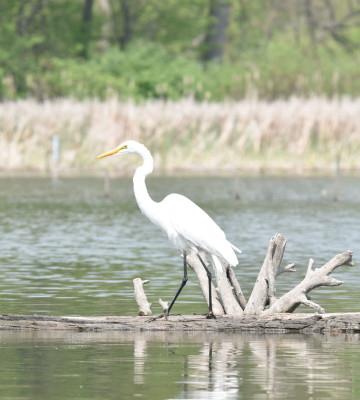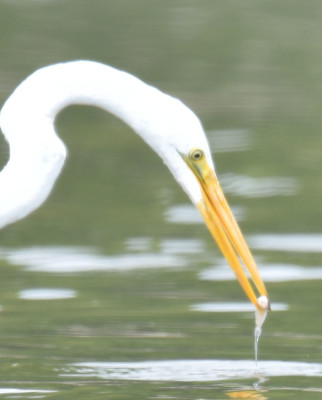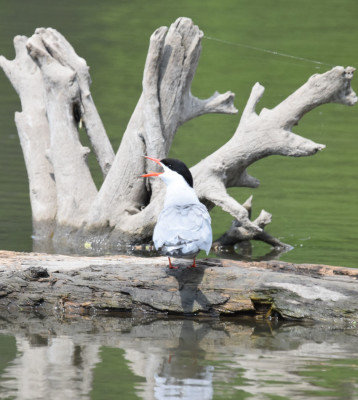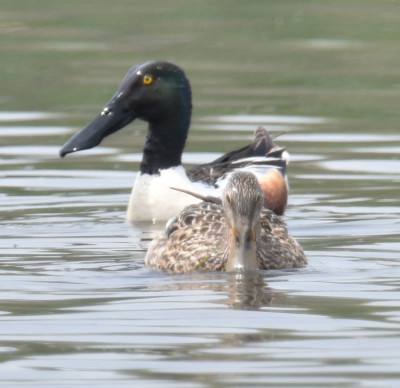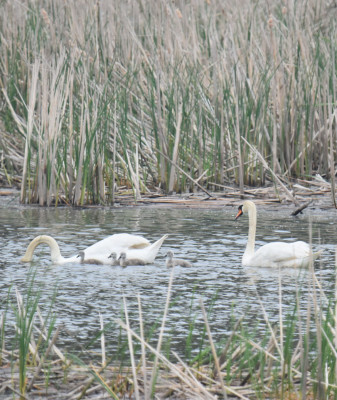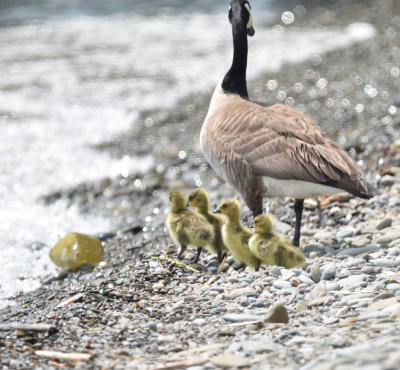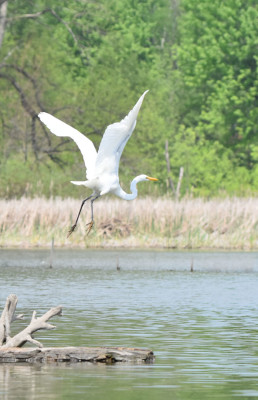Freeman Patterson, a famous photographer whose books I am enjoying reading, talks about working in the rain. He finds the light can be interesting and useful as the weather changes. I also find less-than-stellar weather useful but not because I am good at taking low-light photos. When the weather isn’t ideal, there are usually fewer people visiting the nearby parks which reduces the tendency of wild creatures to move back from the trails and reduces the number of times I feel that I am in someone’s way if I stop to take a photo. I also find some of the creatures that prefer dawn and dusk are more likely to be active, either lingering longer into the morning, or starting the evening’s activities earlier in the afternoon. So this morning, when a light rain was pin-dropping down on the sidewalks, I decided to try a walk at the Rattray Marsh in Mississauga to look for birds, spring flowers and anything else I could identify.
Who’s the Greatest? Comparing a Great Egret and a Great Blue Heron
From the main board walk, I noticed a Great Blue Heron and a Great (White) Egret both stalking through the waters in the lagoon.
Much to my surprise, I was able to walk along the shingle beach beside Lake Ontario to the lagoon outlet to get a closer look at the two birds. Usually they either spot someone and leave, or are chased away by a dog in for a swim long before I get near. While one dog did follow me out almost as soon as I had arrived, fortunately its owner had it on a leash and kept it a bird-respectful distance back from the lagoon edge. (Yes, I was also quite far back: these photos were taken with a 600 mm lens and then cropped which is partly why they are fuzzy.)
You can see this Great Blue Heron is in adult breeding plumage. It has wispy white feathers on its body and the plumes on the back of the head are long and obvious.
This Great Egret, however, is not in breeding plumage. It would also have lots of long, silky looking white plumes if it was. I don’t know if this is a bird that already bred further south this year or if it is not mature. (We saw Great Egrets feeding their chicks in their nests in Florida in mid-March one year.)
Size-wise, the Great Blue Heron is “greater.” According to the Sibley Field Guide, these herons can weigh 2.4 kg (5.3 lbs) and Great Egrets can weigh 0.87 kg (1.9 lbs.)
Both were having success hunting for baby-finger-sized fish. I watched the Egret catch and eat 3 during the short time I was there.
I didn’t see the Heron catch as many fish because it walked away from where I was very soon after I arrived. Herons at the Rattray tend to be a bit shy of people. The Egret, however, didn’t seem bothered by me at all and came towards me several times during its explorations.
A Common Tern Takes a Rest to Preen
At one point, the Great Egret decided to step up onto a log and stump combination near me. I had seen a Tern roosting on that same log earlier. When the Egret stood up, a Tern, probably the same one, came shrieking down at it. The Egret ignored the stream of vituperative insults, though, and continued inspecting the waters for unsuspecting prey. After the Egret moved on, the Tern landed again and stayed for several minutes, venting its spleen by calling at any other Terns foolish enough to come near.
Expected and Unexpected Ducks Share a Common Passion for Eating
Although it was the Heron and Egret that drew me to the shingle bar at the outlet, it was the ducks that surprised me the most. Among the usual group of bachelor male and paired Mallards, were three other types of ducks.
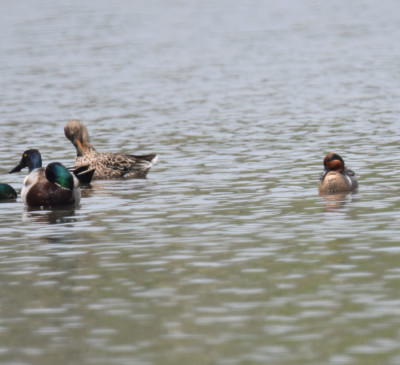
The teal is on the right, the pair of shovlers are behind the male mallard.
One duck was relatively tiny compared to the nearby Mallards. Most of the time, its head was submerged, leaving little above water to identify it from a distance. But when it raised its head the bright colours made the id obvious: this was a male Green Winged Teal. It’s possible a female was foraging just out of sight. Or maybe she’s nesting.
The bright side colours of the male Shovelers made them easy to spot. The female was trickier. I waited till she had raised her head to show off her enormous bill before I concluded there was a female with them. After watching for a few minutes, I realized the female was paired with one of the males and they stayed very close together. The other may be a bachelor or there may be a second female that I overlooked in the cluster of mallards. I checked AllAboutBirds and it seems unlikely that these birds will remain much longer as they normally spend their summers out west.
The third unexpected duck was also a male. It was an American Wigeon which was not in full breeding plumage. It’s quite possible that I overlooked a female Wigeon as I wasn’t sure what features to look for. Wigeon also don’t normally nest in this area, so it may be leaving soon.
Goslings and Cygnets Explore Under Their Parents Watchful Eyes
There are two pairs of Mute Swans nesting at the Rattray this spring. One pair was escorting 4 silver cygnets on an expedition in the calm waters. The other female is still incubating a nest of eggs while her mate swims patrols nearby in the lagoon.
Out at the shingle beach, I met a Canada Goose family. They also had 4 offspring. The fuzzy yellow goslings were walking along the rocks while their parents walked between them and the rather strong surf breaking on the shore. I’m not sure if they eventually went into the water or if, more likely, they turned and went inland into the marsh.
While In Turn, the Cooper’s Hawk Keeps a Watchful Eye on Me from Her Nest
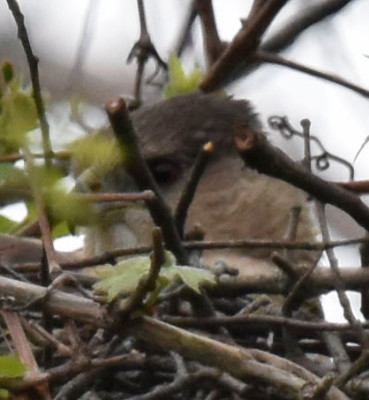
This photo was brightened a bit which has changed her black head into a greyer colour.
I checked on the Cooper’s hawk nest as the thunderclouds rolled in. As usual, when I looked up at the tangle of sticks, I met eyes staring down at me. While it’s unlikely that a person 10 metres down and 20 metres away poses any threat, the hawk still watches every passerby carefully. I don’t know if she has eggs still or chicks. Given the approaching storm, both would benefit from her presence.
Just as I passed the Cooper’s nest, I heard the first low rumbles of thunder in the distance. I didn’t fancy being caught out in a lightning storm, so I briskly retreated. Good thing too, as minutes later, the skies opened and two weeks over-due rain began to fall.
Related Reading
- These Ducks Have Enormous Bills
- A Large White Wading Bird Stalks Through the Marsh
- Why is a Grey and White Heron Perched In a Tree in the Sunshine?
- A Close Encounter with a Cooper’s Hawk (Or a Sharp-Shinned)
- Ontario’s Fishing Birds
Join In
Have you seen any good birds in your local park recently? Please share your sightings with a comment.



